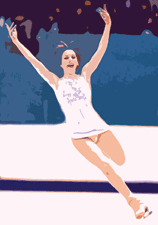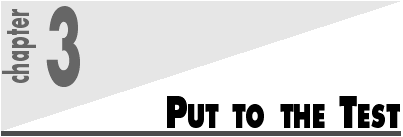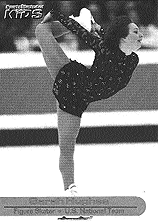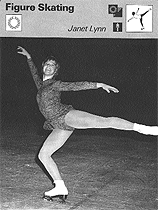Golden Edge
![]() oward
the end of 1994, Sarah started working with Robin Wagner. Wagner, 36, had
skated competitively as a teenager. She rose to the national junior level
in the mid 1970s, and even appeared in a Sesame Street video on figure skating
before calling it quits so she could attend college. Wagner was known for
her smooth, graceful style and her ability to connect with the crowd. “People
always said I had a lot of charisma when I performed,” Wagner remembers.
“They say I really got out there and you could see I loved performing.
And I did.”
oward
the end of 1994, Sarah started working with Robin Wagner. Wagner, 36, had
skated competitively as a teenager. She rose to the national junior level
in the mid 1970s, and even appeared in a Sesame Street video on figure skating
before calling it quits so she could attend college. Wagner was known for
her smooth, graceful style and her ability to connect with the crowd. “People
always said I had a lot of charisma when I performed,” Wagner remembers.
“They say I really got out there and you could see I loved performing.
And I did.”
Wagner stopped skating completely
and threw herself into her studies. She attended Barnard College in New York
City, and graduated with a psychology degree. She worked for her father for
10 years. He owned a magazine publisher, and hoped she would one day take
over the company. But Wagner lacked his passion for the business and left
to become a buyer for Bergdorf Goodman, a Fifth Avenue department store. Although
skating rarely entered her mind during this period, she was unwittingly acquiring
the kind of knowledge that would make her an excellent skating coach. She
understood how the human mind works, she knew how to run a detail-
oriented business, and she had developed a firm grasp of fashion design
and a keen sense of consumer tastes. In an interview prior to the 2002 Olympics,
she looked back on her life and admitted as much: “I think that every
experience that I had doing things other than skating has greatly helped me
to become a better coach and understand the things around me that are going
on.”
In the 1980s, Wagner decided to do a little coaching on the side. She stopped by Sky Rink on 57th Street in Manhattan to get her skates sharpened, and came across a practice for the Ice Theatre of New York. After realizing how much she missed skating, Wagner joined the company and performed with them for a couple of seasons. All the while, she took on more and more coaching jobs—at one point she had pupils at seven different rinks. Sometimes Wagner would lose track of where she was supposed to be and show up at the wrong place. But she loved it. “Each kid had something different to offer,” she explains. “If you were having a rough day with one kid, you knew twenty minutes later you were switching off and working with somebody else...every kid had strengths and weaknesses and it made me grow as a coach.”
![]()

In Golden Edge, Mark Stewart and Mike Kennedy assemble for the first time a truly complete picture of Sarah Hughes. In examining her past the authors leave no stone unturned; in assessing her future they pull no punches.Golden Edge takes you inside the world of figuring skating and chronicles the rise of the sport’s most surprising star.
For someone who had been away from skating for so long, Wagner had an excellent grasp of music and choreography. That is what first attracted the Hugheses to her in 1994. For several years, in fact, Wagner worked primarily on choreography with Sarah. During that time, the two talked about other aspects of skating. Not only did Wagner become a sort of surrogate coach, she and Sarah also grew quite close.
Wagner would design programs, pick music and select costumes. She was perfect for Sarah at this stage of her career. She understood how pre-teen skaters evolve, and that there was no set speed or schedule for Sarah’s progress. From an artistic standpoint especially, sometimes things could be accelerated, and sometimes they had to slow down. This might not have happened at a training center, where Sarah would have been one of many girls constantly competing against one another, possibly pushed too hard or too far or too fast. The only drawback to their collaboration was that Wagner, like most skaters, had jumped counter-clockwise when she competed. Sarah jumped clockwise, so as a choreographer, Wagner had to design moves with counter-clockwise spins then translate everything to its mirror image.
Sarah’s first competition under Wagner’s tutelage was the North Atlantic Regional Novice Championships in the fall of 1995. Novice is the third-highest level of the United States Figure Skating Association’s seven tiers. Above it are the Junior and Senior divisions. Only skaters at these three levels can compete in the U.S. Championships. The North Atlantic Regional was by far the biggest event in Sarah’s young career. She had proved in the past that she was a “pressure player,” so the Hugheses watched with great interest to see how Sarah would respond.
As always, Sarah glided through
her programs relaxed and confident. Though perhaps not as graceful as the
other girls, she landed her jumps and presented well to the judges. Sarah
finished third, which earned her a berth in the Eastern Sectional competition.
From there, the U.S. Novice Championship in San Jose, California was just
a clean routine away. Unfortunately, Sarah faltered and finished 10th. She
still had a great time, and considering her age she had done far more than
anyone expected. More important, skating people were beginning to take notice.
In 1996, Sarah had an opportunity to move up one level to Junior status, but
decided to remain a Novice for one more season. Although her aggressive and
fearless personality had begun to reveal itself, at age 11 she was (and still
is) a perfectionist. It rubbed her the wrong way to advance to the Juniors
when she knew she still had something to prove as a Novice. So Sarah skated
one more season, returned to the North Atlantic Regional and won the Novice
competition. At the Eastern Sectional, she improved to sixth. Now it felt
right to move up and move on.
Since Sarah’s sixth-place finish was not good enough to get her to the Nationals, she focused her attention on getting certified as a Junior by the USFSA. This is no simple matter. A skater must execute a series of advanced maneuvers before a group of association officials, who determine whether she is skilled enough to compete on the next tier. Mastering the requisite moves for the Junior test took a lot of extra ice time, which Sarah was willing to put in. She knew what the move up required and was prepared to make the commitment.
Sarah was not prepared, however, for the news that her mother had breast cancer. She was barely old enough to comprehend what cancer was, but she could see the impact it had on the family. During 1997, Amy spent a lot of time in the hospital. Her treatment included chemotherapy, stem-cell therapy, and eventually a bone-marrow transplant. For the first time in her life, Sarah didn’t have her mother to lean on, and her reaction was fascinating. She became incredibly protective of her mother and was reluctant to leave her side.
At the same time, Sarah began to view her skating in a new light. Life suddenly seemed to her like a never-ending series of surprises; she found that one place she could exert total control over her environment was on the ice. Her parents noticed a change come over her—a new seriousness, a new dedication, a new determination. In the spring of 1997, not long after her 12th birthday, she landed her first triple jump. Shortly thereafter Sarah passed her Junior test.
The new level of intensity Sarah
brought to her skating did more than sharpen her technique. She also found
a way to channel this intensity in artistic ways. Her presentation was still
quite rough around the edges, but it seemed to improve by the week. It was
an exciting time, especially for Robin Wagner, who was witnessing 30 months
of hard work all pay off at once.


